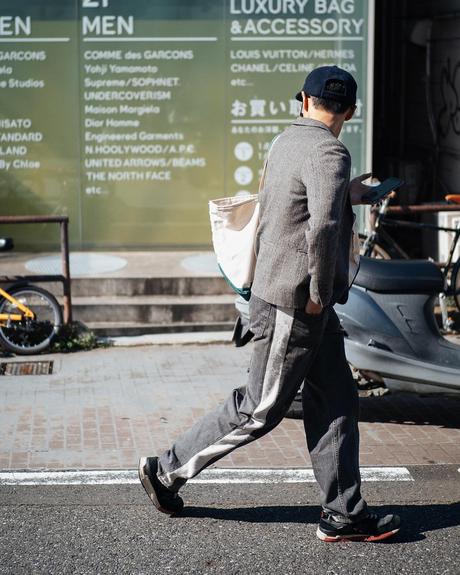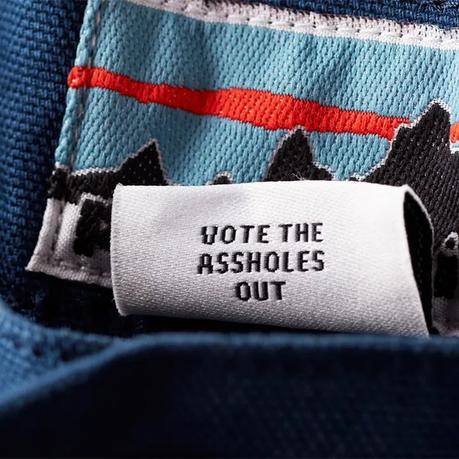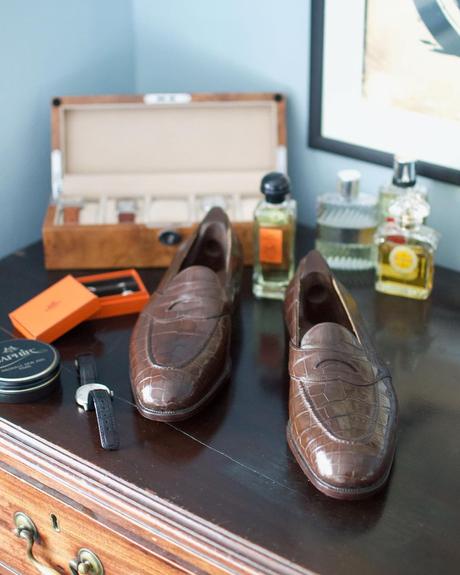
In the social science literature, the term "critical juncture" is used to describe a moment when significant changes can occur rapidly, knocking institutions and culture onto a new developmental course. In the last year, many have debated whether the coronavirus pandemic is such a moment. Is remote work morphing into a more permanent reality? Will we be wearing coffee stained t-shirts and elasticated pajama bottoms forever? Are we witnessing the death of hype culture and the emergence of a more thoughtful fashion consumer? In a recent New York Times interview, Raf Simons expressed skepticism over whether liberal market economies can be permanently bent and reshaped. "The one lesson I think fashion will not learn from this, which is the one it should learn, if I am brutally honest, is that it should be less greedy," he said. "It became too much this economic machine. For the majority, the first desire is economic growth. [...] And you can't do that with only one or two collections a year."
It's been one year since the first case of coronavirus was reported in the United States. Since then, some things have changed, although their permanence is yet to be determined. After J. Crew filed for Chapter 11 protection in May of last year, other corporate giants toppled like dominos - Neiman Marcus, Brooks Brothers, J.C Penney, Men's Warehouse, Aldos, and John Varvatos among them. That has sent shockwaves throughout the global supply chain, affecting heritage producers such as Vanners Silk Weavers. The Gap and H&M, two mainstays in high-street retailing, announced plans to shutter hundreds of stores in this coming year. And for every one of these headlines about big industry names, countless small businesses don't get nearly enough attention. Last year, New York City lost over 500 small businesses alone. The Partnership for New York City, an influential business group, estimates that about a third of the city's 240,000 small businesses "may not make it to see the post-vaccine promised land."
Last December, as the year was drawing to a close, I wondered what are some of the year's most defining themes. (Yes, this is a "year in review" post, which comes a month late, but please cut me some slack, as I've been dealing with a pandemic, a recession, and an insurrection.) Some of the things that have transpired were many years in the making, just accelerated and taken to the extreme. The Casual Friday movement that started in the 1990s has now ended with all of us in sweatsuits and t-shirts. The decline of suburban malls, department stores, and other general merchandise stores has morphed into a total brick-and-mortar meltdown, threatening to reshape the American landscape. Online shopping is at an all-time high, which has created a new demand for shipping supplies. Environmentalists are now bracing themselves for all the corrugated containers, plastic packaging, shrink wrap, bouncy air pillows, and bubble mailers that will wind up in our landfills, incinerators, and natural environment. To be sure, these are the real themes of last year. But along with these very obvious concerns, what else defined fashion in 2020?
 The Trend Machine Broke Down
The Trend Machine Broke Down Perhaps the most striking is the relative paucity of trend reportage. Whereas as previous years can be bookended with specific items and aesthetics - dadcore, normcore, and gorpcore; black double riders, elongated tees, and zippered sweats; Demna and the rise of Bad Taste; campy patchwork, chunky sneakers, and Aloha shirts - the fashion industry went into a freeze last spring.
In some ways, the pandemic has punctured the illusion that trend reportage is democratic, rather than just another way to manufacture consent. In the last fifteen years, power has shifted away from traditional fashion tastemakers, such as editors and prominent celebrities, and towards online influencers and street style photographers. But, as it turns out, this New Guard is also just creating fantasy. The pandemic has forced jet setting influencers to stay at home, confining them to the same boring lives all of us lead. Fashion tradeshows have been canceled; the "sidewalk economy" struggles to find its preening peacocks. The collapse of this influencer eco-system has meant a breakdown in the trend-generating machine.
"It seemed to me that for the past few years, fashion existed in a very manufactured or regimented cycle of trends," says Rachel Tashjian, Style Writer at GQ. "An ugly shoe would become popular, then it's a Bottega Veneta stomper boot, and now everyone has a truly tiny Jacquemus bag. By popular, I mean that it would generate a lot of conversation on social media, or you'd see it on a slew of people on Instagram, or there'd be an article proclaiming something was a trend. In my experience, a lot of trend reporting is a fallacy. Are a bunch of people actually wearing or buying this thing, or is it just a handful of people with big fashion discounts? Isn't it likely that people are buying or craving this thing to participate in a shared delusion of clothes-as-community? I think last year disrupted that system in many ways, or at least made the system more transparent."
With fewer drops, fashion shows, and influencers flexing on Instagram, writers have had to pay closer attention to real people. And to some degree, this has made trend reportage a little more democratic. "Personally, I can't imagine a world in which there are no trends," says The Cut's Emilia Petrarca. "Please don't read that with a hoity fashion voice. I just mean that behavior patterns will always emerge among groups of people, even if they're not physically together. Instead of traditional trend coverage, like 'pink is the new green,' we're seeing more of 'everyone is buying this one culty brand of sweatpants.' Or 'this one guy made cute face masks in his kitchen, and now a huge swath of Brooklyn wears them.' If you want to write about trends now, you have to look at, and ask questions about, what people are actually doing and buying, as opposed to making something up based on what's been cooked up for show. Function is playing a way bigger role in what I buy now. Like, can I sit in these pants for hours? Will I stain them at the park? Is underwear built in? (Jk but not really.) I may be trying to impress people less, but I can't say that I'm not influenced still by what I see online and around me."

Fashion Writing As Social Commentaryhow it's felt to write about fashion these last four years pic.twitter.com/2B4Fx02Nbq
- derek guy (@dieworkwear) January 16, 2021
It's become increasingly difficult in the last four years to talk about fashion - or, indeed, any subject - without bringing up some political dimension. This has always been true of clothing, as we use clothes to signal our tribal identities and personal values, which often dovetail with our politics. But in the last year, talking about clothes without bringing up politics feels as tone-deaf as the star-studded "Imagine" singalong. With the deadly pandemic, historic recession, Black Lives Matter protests, and tense US Presidential election, talking about clothes as standalone objects feels too much like navel-gazing. "Fashion media has always discussed politics, but after the election of Donald Trump, it's become more evident that a lot of fashion writing is social commentary," says Jian DeLeon, the former Editorial Director at Highsnobiety, and now Men's Fashion & Editorial Director at Nordstrom. "On the surface, a lot of fashion writing is about clothing. But when you look deeper, it's also often about the paradigm in which that clothing exists."
Some of the most critical moments in fashion last year weren't even about the clothes, necessarily, but how we cover clothes. Elizabeth Paton wrote some excellent reportage on environmental sustainability, sexual assault, and labor rights in fashion. Large media companies such as , , and Highsnobiety have been reporting more about Black designers and issues; No Man Walks Alone, a sponsor on this site, donated to BLM causes and launched a mentorship program for Black-owned businesses. Tashjian also wrote about Man Repeller's abrupt closure in October. A trailblazer in the womenswear space, Man Repeller founder Medine Cohen has been credited with creating an online space for quirky personal style, but then failed to evolve the site's identity even as the world was rapidly changing. "The rise and fall of Man Repeller serves as a cautionary tale about the pitfalls of asking too much of our clothes," writes Tashjian, "attempting to spin every idea into a politically-charged movement."
Petrarca captured what I think was the only real fashion trend last year: merch. "Merch has always been popular, [...] but when the shutdown came, many of us found our values shifting toward causes both local and political. Buying merch to support a struggling neighborhood business felt more altruistic." If there was one thing seemingly everyone was buying last year, it was t-shirts for various political causes and neighborhood shops. "Quarantees" allowed us to wear our heart on our sleeve, and made us more aware of what we're supporting.
 Reevaluating Our Relationship with Clothes
Reevaluating Our Relationship with Clothes Nearly six months after the first US lockdown was announced, Irina Aleksander wrote what I think is last year's best fashion article, an NYT Magazine piece ominously titled "Sweatpants Forever." Her article tells a story of what has happened to the fashion industry in the last twenty years - the nonstop culture of releases and trends, the hype, and the ever-increasing hunger for profits - by starting with a small tale of Scott Sternberg's new leisurewear label, Entireworld. Sales for sweatsuits, t-shirts, and soft, stretchy loungewear last year constituted the one bright spot in an otherwise ailing apparel market. With the lockdowns and potential for permanent telecommuting, many have been wondering if we'll be wearing sweatpants forever.
By the end of the year, however, attitudes shifted. As Rhonda Garelick wrote in The New York Times, fashion has always been disrespected because it codes as a feminine interest. "Anti-fashion prejudice has a long history, intertwined with sexism and misogyny," the fashion professor writes. "Critics and philosophers have been deriding fashion for millenniums, using it as a symbol for every manner of human weakness: duplicity, depravity, narcissism, frivolity, greed - attributes also ascribed traditionally to women. Often, fashion becomes a kind of literary shorthand, a metaphor, for the failings of the female sex. [...] [T]his cycle of fascination [is] followed by rejection. The rhythms of this process mirror the deepest parts of our conflicted, decadent, yet anhedonic Western psyche: an attraction to pleasure, sex, bodies, and beauty, followed by the swift denunciation of these same elements. It's the superego battling the id, the Catholic confessional. Indulge, repent. In a patriarchy, women bear more of the stigma for these 'moral failings' because they occupy (metaphorically) the realm of flesh and sex, of indulgence and aesthetic enjoyment. Fashion occupies these realms too, and so winds up shouldering the burden of cultural and psychological ambivalence."
If you wore suits or sport coats in the Before Times, do you plan on wearing tailored clothing more, less, or about as often in a post-vaccine world?
- derek guy (@dieworkwear) January 24, 2021
Yet, this last year has emphasized how much fashion is integral to our existence. Fashion is the most intimate form of communication, as it literally touches the body, and it's deeply rooted in our impulse to "adorn the self, to communicate sensuously, to participate in the social collectivity, and lend it shape and legibility." It's the communicative aspect that people miss most, not just the act of dressing up in the morning. Confined to our home and with nowhere to go, many miss the feeling of being seen. Over the summer, I was skeptical of the few fashion writers who said they yearn to dress up again. By the end of the year, that theme was so clearly echoed by others, it became a chorus. As Rachel Syme writes in her New Yorker article "A Year Without Clothes," she doesn't just miss dressing up, but the feeling of moving through the world in her favorite attire.
The only time I dress up in 'outdoors' clothing now is to hop into a Zoom meeting or get-together. I toss on a satiny blouse, big earrings, and a swipe of red lipstick, but my heart isn't fully in it. Is an outfit still stylish if it is only a simulacrum of what you would wear to go somewhere (and if you rip it off right after the call ends and change into a stained sweatshirt?). Fashion, for me, has always been about the experience of moving through the world in clothes; as the infamous editrix Diana Vreeland said, 'You gotta have style. It helps you get down the stairs.' How does style change when you're pleasing yourself alone? [...] [W]hat I've felt, perhaps, is a yearning for the spontaneous ways that clothing and public life can collide - the feeling, say, of riding the subway, en route to a holiday party, wearing something sparkly and foolish underneath a puffer coat. [...] I've been visiting it in my closet, imagining the adventures we may have together when I can go to theatres and dark bars again. I've started to sort through my old high-heeled boots and bedazzled dresses - not culling them, because any item that whispers of future outings sparks joy for me, but reorganizing for the day I can wear them again. I'm homesick for the city I live in, and I miss the clothing I already have.
More than frivolity or a hedonic treadmill, fashion has proved to be an essential part of many people's lives. Over the weekend, I conducted an informal and highly unscientific Twitter poll, where I asked people if they plan to dress up more or less in a post-vaccine world. I was surprised to find that most people answered "more" or "about as often as before." Only 20% of respondents answered "less." Perhaps 2020 helped us highlight the best parts of fashion - how much clothing means to us; how to detach ourselves from the trend generating machine and develop true personal style; and how to think harder about the more substantive issues surrounding clothes, including labor rights, environmental sustainability, and culture. It remains to be seen whether those lessons will stay with us or if they'll fade into a distant memory.

